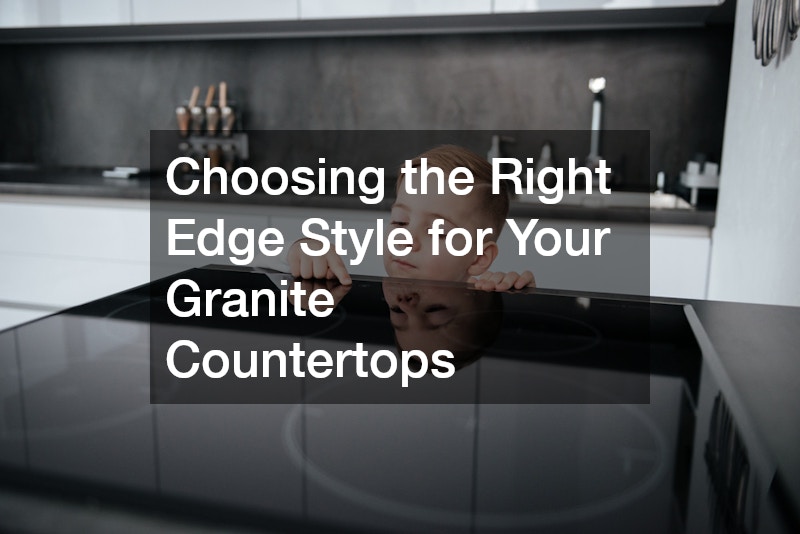Understanding the different edge styles for granite countertops is essential for both aesthetic and functional reasons. Each style offers unique characteristics that can complement various kitchen designs while impacting the functionality of the space. This guide will help you choose the perfect edge style by addressing common concerns and preferences, ensuring that your selection enhances the overall appeal and usability of your countertops.
The Most Popular Edge Styles for Granite Countertops
Classic Edge Styles
The beveled edge is a popular classic choice, featuring a sleek angle that adds a sophisticated touch to any countertop. Its sharp lines offer a timeless look while also helping to mask minor imperfections on granite surfaces.
On the other hand, the bullnose edge presents a rounded finish that is not only aesthetically pleasing but also provides a safety buffer for families with young children.
The ogee edge style is recognized for its elegant, intricate curves, making it an ideal option for those seeking to add a touch of luxury to their kitchen. This style is often chosen for traditional kitchen designs, as its opulence enhances classic cabinetry and fixtures. When selecting a classic edge, consider how each profile can harmonize with your kitchen’s existing elements and personal taste.
Contemporary Edge Styles
Mitered edges create a seamless look that is excellent for achieving a thick, bold countertop statement, ideal for contemporary designs. This edge style adds a modern touch, blending neatly with sleek cabinetry and minimalistic decor. The mitered edge is also versatile, allowing for the incorporation of different materials to add a unique artistic dimension to your space.
The waterfall edge is another contemporary choice that extends the countertop material over the edge and down to the floor, offering a continuous flow that enhances open-plan spaces. This style is particularly popular in high-end kitchens and islands, as it can dramatically emphasize the beauty of the granite. A waterfall edge not only serves as an eye-catching design element but also reinforces the structural integrity of the countertop.
How Edge Styles Affect Functionality
Durability and Maintenance
Edge styles significantly influence the durability of granite countertops, with some options being more resilient to wear and tear. For instance, rounded edge styles like the bullnose are less prone to chipping compared to sharper edges, such as bevels. Understanding these differences is crucial for selecting an edge that maximizes the longevity of your countertops while maintaining their pristine condition.
The ease of maintenance is also impacted by the choice of edge style. Smoothed and rounded edges tend to gather less dust and grime, making routine cleaning less time-consuming. Conversely, more intricate designs might require additional attention to detail during cleaning to ensure particles don’t accumulate in grooves.
Safety Considerations
When it comes to safety, edge profiles play a crucial role, especially in homes with active children or high-traffic kitchen areas. Opting for rounded edges like bullnose or demi-bullnose can significantly reduce the risk of injuries caused by sharp countertop corners. These styles offer peace of mind without sacrificing the aesthetic appeal of the granite.
On the other hand, sharper edges, while elegant, may pose a higher risk of accidental bumps or bruises. Therefore, households with young children or elderly residents should carefully weigh these considerations when deciding on the edge style. It’s essential to prioritize an edge style that accommodates both design preferences and the safety requirements of those who use the space daily.
Choosing the Best Edge Style for Your Space
Considerations for Personal Style
Personal style plays a pivotal role in the decision-making process when choosing the right edge style for your granite countertops. It is vital to consider how the edge style aligns with your existing kitchen decor and overall aesthetic goals. For contemporary kitchens, a mitered or waterfall edge might complement modern appliances and clean lines seamlessly.
Meanwhile, those who favor traditional or rustic interiors might find that classic edges like ogee or chiseled styles better reflect their design tastes. These styles invoke a sense of warmth and class, which can be perfect for a home that embraces a charming and cozy atmosphere. It’s important to visualize how the edge style will pair with other elements such as cabinetry, flooring, and accents to create a cohesive look.
Budget and Cost Implications
The budget is a crucial factor when determining the appropriate edge style for granite countertops, as costs can vary significantly based on complexity and labor requirements. Simple edge styles such as eased or bullnose are often more affordable due to their straightforward fabrication process. In contrast, more intricate designs like ogee or waterfall may require specialized skills and increased installation time, thus driving up costs.
Material costs can also influence the overall budget, as thicker countertops may necessitate mitered edges to achieve a substantial look while avoiding excess material wastage. It’s essential to balance the desired aesthetic with budgetary constraints, ensuring that the chosen edge style fits comfortably within your financial plan. This careful planning prevents unforeseen expenditures that could disrupt the completion of your renovation project.
Choosing the right edge style for your granite countertops involves balancing aesthetics, functionality, safety considerations, and cost. Each edge style brings its unique set of characteristics, impacting both the visual appeal and practical use of your countertops. By understanding the options and their implications, you can make a well-informed decision that enhances your space, whether for contemporary flair or timeless elegance.




